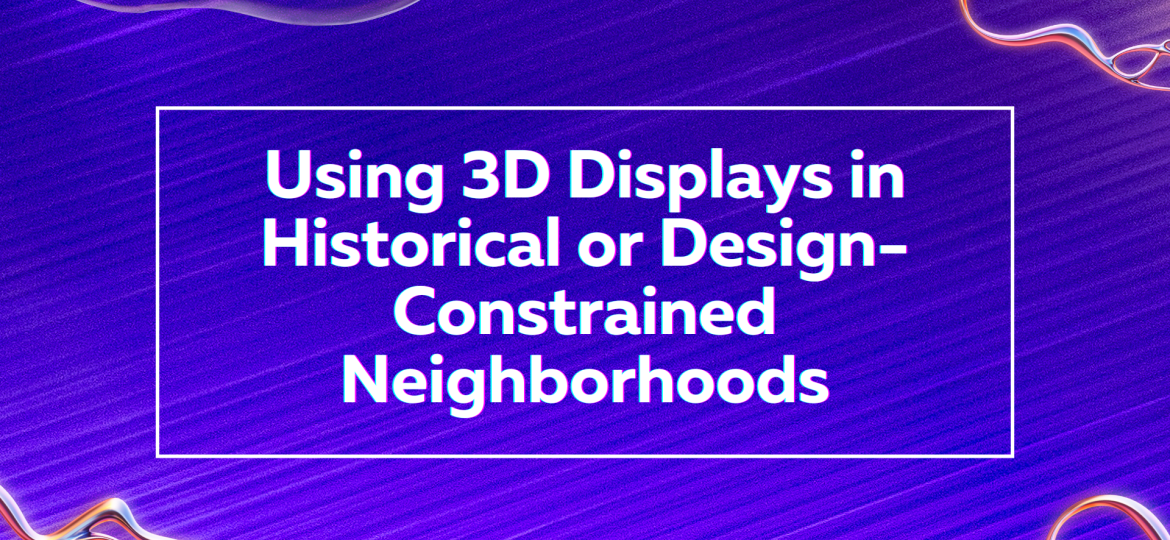Using 3D Displays in Historical or Design-Constrained Neighborhoods
Using 3D Displays in Historical or Design-Constrained Neighborhoods
Marketing in heritage districts comes with its own unique set of challenges. Beautiful old buildings, cobblestone streets, and carefully preserved architecture create charm, but they also limit what businesses can do to stand out. For brands accustomed to bold signage or cutting-edge displays, these restrictions can feel frustrating.
The reality is that 3D displays in historical neighborhoods are rarely the right fit. Strict signage codes, design boards, and community preservation priorities make them impractical in most cases. But that doesn’t mean your marketing is stuck. Businesses can thrive by understanding these limits, knowing where 3D displays don’t belong, and focusing their investment where the technology delivers maximum impact, like in modern malls and commercial centers.
1. What Makes Marketing Hard in Historical Districts?
Heritage neighborhoods are often managed by local preservation boards or city planners. Their mission is to protect architectural integrity, and that means keeping visual harmony intact.
For business owners, this creates a series of hurdles:
- Size restrictions: Signs are often capped at modest dimensions that won’t overwhelm old facades.
- Material requirements: Wood, iron, or muted colors may be mandated, leaving little room for innovation.
- Lighting bans: Bright LEDs or flashing visuals are usually prohibited.
- Approval delays: Any signage change may require multiple rounds of review, eating up valuable time.
While these rules serve a cultural purpose, they often leave businesses struggling to grab attention in busy pedestrian areas where every storefront looks similar.
2. Why Traditional Signs Don’t Always Work Anymore
Even when rules are followed, traditional signs don’t always deliver results in 2025. Today’s consumers are conditioned by a flood of moving, glowing, and interactive content. A flat wooden sign, no matter how carefully designed, can be overlooked in seconds.
- Visual fatigue: Passersby tune out static signage after a glance.
- Competing distractions: Phones, digital ads, and urban noise dominate attention.
- Predictability: Most signs in heritage districts look nearly identical, which makes it harder for one business to stand out.
The challenge isn’t just getting noticed — it’s convincing people to pause long enough to walk inside.
3. Why 3D Displays Rarely Work in Historical Areas
Some business owners wonder if introducing 3D displays in historical neighborhoods could cut through the noise. While the technology is groundbreaking in malls and urban hubs, it clashes with the goals of heritage zones.
Here’s why:
- Too bright, too modern: Floating holograms or motion visuals stand out in ways that conflict with the district’s aesthetic.
- Zoning restrictions: City bylaws often ban electronic signage outright.
- Cultural preservation: Residents and planners value authenticity. Modern tech can be seen as disruptive.
- Approval roadblocks: Even if proposed, 3D displays are unlikely to get greenlit by preservation boards.
Instead of trying to push boundaries where they don’t belong, it’s smarter to acknowledge that heritage areas are about subtlety, not spectacle.
4. Where 3D Displays Work Best
The strength of 3D displays lies in environments built for modern commerce. These spaces not only allow for innovation but also encourage it.
- Malls and shopping centers: With heavy foot traffic, indoor comfort, and shoppers primed for discovery, malls are perfect venues for holographic displays. Floating visuals of sneakers, jewelry, or food can stop people mid-walk.
- Commercial hubs: Downtown financial districts and retail strips welcome high-tech signage that drives engagement.
- Event spaces: Trade shows, expos, and stadiums thrive on immersive, eye-catching content.
- Transit areas: Airports and train stations provide long dwell times, making 3D advertising effective.
By focusing resources on malls and other innovation-friendly spaces, businesses maximize their return. The payoff is visibility, engagement, and a clear differentiation from competitors relying on traditional static signage.
5. Steps to Market Effectively in Heritage Districts
If your store is located in a historical neighborhood, you’re not without options. You can still make a strong impression while staying compliant.
- Enhance your window displays: Seasonal themes, curated product arrangements, and creative lighting (within limits) can make your storefront stand out.
- Use storytelling in signage: Heritage zones reward authenticity. Use your signs to highlight history, craftsmanship, or local ties.
- Experiment with QR codes: While static in appearance, QR codes can extend engagement digitally without breaking rules.
- Focus on in-store experiences: If your outside can’t say much, make your inside memorable enough that word spreads.
The key is to respect the setting while still finding ways to intrigue passersby.
6. Long-Term Marketing Balance
The best marketing strategy is one that adapts to the environment. In heritage districts, this means subtlety, respect, and compliance. In malls and modern retail hubs, it means bold visuals, innovation, and immersive technology.
By separating these approaches, businesses can maintain credibility where tradition matters and capture attention where creativity thrives. Instead of forcing a one-size-fits-all approach, smart marketers invest in 3D displays where they can shine — in malls and high-traffic modern spaces.
Conclusion
Reusing outdated visuals or pushing high-tech signage into the wrong setting weakens both message and brand. 3D displays in historical neighborhoods may not be the right fit, but they are transformative in the right environment. Malls, retail hubs, and commercial centers give this technology the stage it deserves.
Businesses that embrace this balance protect their brand image in heritage zones while driving engagement where innovation belongs. If your goal is to connect with today’s shoppers in ways that feel modern, memorable, and effective, investing in 3D display advertising in malls is the smarter path forward.
With Creativ Buzz, businesses can access premium 3D display slots in top malls, turning attention into real customer action.
FAQs
Can businesses use 3D displays in historical neighborhoods?
Rarely. Heritage zones often ban electronic signage to preserve architectural integrity.
Where are 3D displays most effective?
Malls, retail centers, and commercial hubs are where shoppers expect modern experiences.
What are alternatives to 3D displays in heritage districts?
Creative window setups, heritage-compliant signage, and interactive tools like QR codes.




